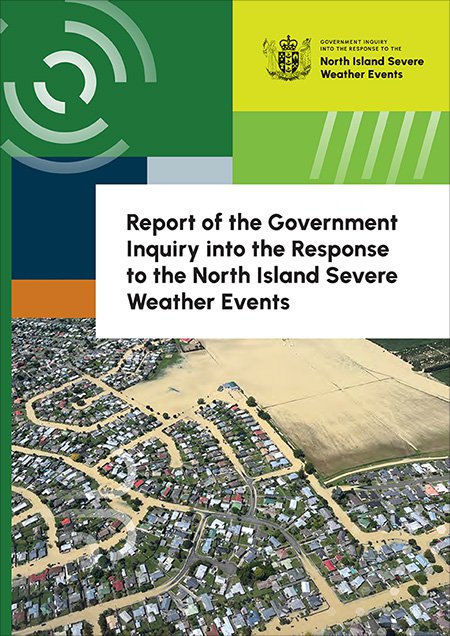Report of the government inquiry into the response to the North Island severe weather events
Author:
Government inquiry into the response to the North Island severe weather eventsSource:
New Zealand GovernmentPublication date:
2024Topics:
EnvironmentPreface (extracts)
1. In early 2023, three devastating weather events struck the North Island of New Zealand within a six-week period. The impacts of Cyclone Hale, the Auckland Anniversary heavy rainfall, and Cyclone Gabrielle will be felt for years to come. Fifteen people died, one person is still missing, and the lives of many more were forever changed. We acknowledge the gravity of these events, and the seriousness of our task.
2. Over the past eight months, our role was to identify lessons from the severe weather events, and to make recommendations for the design of New Zealand’s emergency management system. The aim is to improve our country’s readiness for, and response to, future emergencies.
3. The Inquiry takes a high-level view and does not seek to apportion blame to individuals or entities. Where necessary to identify lessons, we have made it clear where we found the actions of those involved fell below what was needed. In doing so, we equally acknowledge that many who had a role in the response did their job with the best of intentions. ...
Executive summary (extracts)
The severe weather events caused devastation
31. Aotearoa New Zealand uncomfortably sits second on Lloyds of London’s list of most exposed countries to natural hazards. It estimates the average cost of natural disasters to New Zealand’s economy is 0.7% of gross domestic product (GDP) per year. When taken over the past 20 years, noting the impact of the Canterbury and Kaikoura earthquakes, the cost recovering from natural hazards is 4.3% of GDP per year. This cost is forecast to grow. Past and current planning decisions to allow development in medium to high-risk sites means more of our built environment is at risk from earthquakes, tsunami, sea level rise, eruptions, and unpredictable and more frequent severe weather.
32. Cyclone Hale, the Auckland Anniversary heavy rainfall, and Cyclone Gabrielle were collectively the most severe and destructive weather events in New Zealand’s recent history. They resulted in significant devastation to property and ongoing trauma for communities. Most tragically, 15 people died, and a year on one person remains missing. The Treasury estimates the events caused between $9 and $14.5 billion of physical damage to households, businesses, and infrastructure.
33. For those outside affected regions, it is hard to comprehend the pace, severity, and scale at which the weather events unfolded, or the fear and uncertainty people felt as flooding, landslides, slash, heavy rain, and winds swept through homes, businesses, towns and cities. We heard many harrowing stories of people’s efforts to assist others and survive in the immediate aftermath. We saw the ongoing and devastating grief suffered by so many people, affecting their families, livelihoods, and mental wellbeing. These costs are difficult to quantify and will be felt for a long time.
The emergency management system is not fit-for-purpose
34. Thousands of people participated in the response to the severe weather events. In challenging conditions, the actions taken at a community level were powerful. Iwi, hapū, community groups, businesses, voluntary organisations, and individuals rescued people and animals, repaired infrastructure, cleaned up properties and public spaces, and provided practical and emotional support. At the Civil Defence Emergency Management (CDEM) level, the Inquiry observed that those agencies that had carried out effective readiness planning activities prior to the events were better able to respond under the challenging circumstances. ...
March 2024
See also
Government inquiry into the response to the North Island severe weather events
